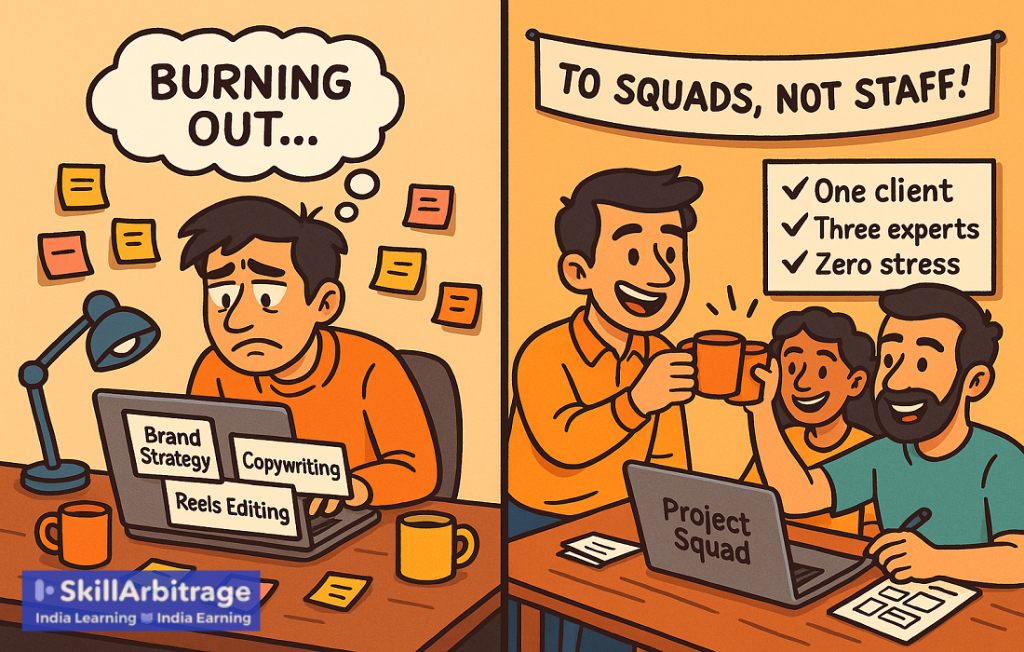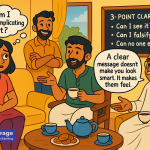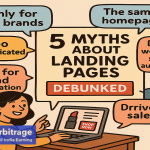This article is for Indian freelancers who are tired of doing everything alone and burning out in the process. You will learn why the smartest move in 2025 is not scaling up into an agency, but teaming up with the right collaborators. By the end, you will know how to build a freelance squad that lands bigger projects, commands higher retainers, and amplifies your identity instead of diluting it.
Table of Contents
Previously in Clarity in Copywriting…
Raja helped Savitha conquer impostor syndrome through clear, no-nonsense writing that builds trust with clients. Now, as their solo hustle shows its limits and burnout sets in, they’re exploring how teaming up can turn individual stress into collaborative strength, delivering full-service offerings, bigger retainers, and a smarter way to win clients in 2025.
(Continued…)
Raja lay back on the bed, arm flung over his eyes. “They wanted brand strategy, landing page copy, ten-email sequences, and a content calendar. I told them I could do half of that and bring someone in for the rest.”
Savitha didn’t lift her head. “Let me guess. They ghosted you.”
“Disappeared like I never existed.”
She turned slightly, still slumped in the chair. “Last week, I said yes to a performance audit, six ad scripts, and a week’s worth of UGC briefs. I spent three hours watching YouTube tutorials on how to edit reels.”
Raja laughed, but it wasn’t a joyful one. “We’re not freelancers. We’re unpaid interns for our own businesses.”
She nodded. “And still somehow not enough.”
Lesson 1: Clients want outcomes, not skillsets
This was the reality they were staring at. Clients weren’t hiring for writing, strategy, or visuals. They were hiring for outcomes. Smooth, end-to-end delivery. Fewer handoffs. Less project management. More results.
Freelancers who couldn’t cover every base were losing to those who teamed up and quietly offered the same scope as a boutique agency, minus the fluff.
Lesson 2: Generalists burn out and collaborators win.
“Everyone’s trying to be a generalist just to stay afloat,” Savitha said.
“And in the process, we’re becoming average at everything and great at nothing,” Raja added.
They didn’t say it, but they both felt it. The era of the solo genius was over. The new power move was partnership.
Freelancers who joined forces weren’t just surviving. They were picking better clients, charging more, and doing better work.
1. Freelancer collaboration advantage
Raja sat up and reached for his laptop. “You remember Ritu, the brand voice strategist?”
Savitha nodded. “The one who writes for that vegan skincare startup?”
“Yeah. She teamed up with Arjun, a web designer, and this guy Keshav, who’s a beast at SEO. They just signed a ₹3 lakh monthly retainer with a SaaS company. One client. Three people. No stress.”
Savitha blinked. “₹3 lakh?”
Raja turned the screen toward her. “They don’t even pitch themselves as individuals anymore. Just a three-person crew. You want a site? Comes with positioning, voice, and search baked in.”
She leaned back in her chair, brain racing.
a. Enhanced skills & expertise
Savitha used to dread brand strategy calls because she had to fake confidence on visuals. She thought every freelancer was supposed to know a little of everything. But watching Ritu’s setup, it was clear: the best freelancers don’t do more. They do less and partner better.
Each of them owned a slice of the work. The result? Cleaner output, fewer rewrites, and no scope bleed.
b. Increased client satisfaction
Raja grinned. “Clients love it. No back-and-forth with five vendors. No messy handovers. They talk to one of them, the team handles the rest.”
“And if one drops the ball?”
“They don’t. Because they picked people they trust, not people they tolerate.”
Savitha opened her notebook. “Okay, so it’s not just about skills. It’s about chemistry.”
“Exactly. That’s the moat.”
c. More business opportunities
Savitha scribbled something down. “And if I refer a strategist I trust, they’ll refer me back when they need ads or scripts.”
“That’s how Ritu got the SaaS gig,” Raja said. “Arjun looped her in. Then she pulled Keshav in. It’s a referral flywheel. Not a partnership of convenience.”
They were quiet for a second.
Then Raja said what they were both thinking.
“We’ve been trying to do everything solo. But maybe the real move isn’t to do more. It’s to find the right people and do only what we’re best at.”
2. This is not an agency
Savitha shut her notebook and looked up. “Okay, but if we team up with others, aren’t we just… becoming an agency?”
Raja laughed, then flopped back on the bed. “That’s like saying a dinner party is a restaurant.”
She raised an eyebrow. “Explain.”
a. No bosses, just partners
“You’re not hiring people. You’re working with equals,” Raja said. “If we did a campaign together, I wouldn’t be your employee. You wouldn’t be mine. We’d split the fee and the credit.”
“No creative directors. No Slack messages at 10 p.m. demanding a deck,” Savitha muttered.
“Exactly.”
b. No permanent overhead
She glanced around her flat. The ceiling fan clicked rhythmically. “So we wouldn’t need an office. Or payroll. Or software licenses for ten people.”
“Nope. Just a group chat and a shared drive.”
c. No bloat, only fit
“Agencies keep people on bench. Writers writing nothing. Designers waiting for briefs. You don’t need that,” he said. “You build a squad for the brief. Not the other way around.”
d. No one owns the client
Savitha looked up sharply. “That’s the part that used to scare me. Agencies say ‘our client.’ But I brought the lead. I did the pitch. And they still gatekeep.”
“In freelance collabs,” Raja said, “you bring the lead, you keep the relationship. You just let others contribute. It’s built on trust, not hierarchy.”
She exhaled slowly.
“So basically,” she said, “we’re talking about friendship with deliverables.”
Raja laughed. “And a much better bank balance.”
3. 3 real strategies for collaboration
Raja stared at the ceiling fan. “Okay, let’s say we don’t want an agency. But we still want backup. What does that actually look like?”
Savitha stood up and paced. “Not theory. Actual ways we can start. Tomorrow.”
a. Joint projects
Raja sat up. “Remember that client who wanted a funnel, a welcome sequence, a brand voice doc, and a case study? I said no because it was too much.”
“You should’ve just brought me in for the strategy,” Savitha said. “Then roped in Sandeep for the copy. And maybe Meenakshi for the funnel build.”
“That’s what I’m saying.” Raja pulled out his phone. “That’s a ₹3L retainer split three ways. Nobody’s drowning. Everyone’s eating.”
They nodded, both thinking of projects they’d said no to because they didn’t want to die doing them alone.
b. Referral networks
“I’ve been doing this quietly,” Savitha said. “When someone wants UX writing, I just send them to Lakshmi. And she sends me branding leads.”
Raja raised an eyebrow. “So you’re basically running a low-key referral mafia.”
“Exactly. We don’t pitch. We just pass the ball.”
She opened her Notion. “I’ve started logging everyone. What they’re good at. What I’d trust them with. I call it my Trust Circle.”
Raja grinned. “I’m stealing that.”
c. Co-branding initiatives
Raja snapped his fingers. “That newsletter you wrote with Harsh. You broke down product strategy. He gave examples from DTC launches.”
“Yup. That one email got me two leads and a podcast invite.”
He nodded. “Let’s push that. We record one Loom audit together—brand plus copy. We post it. People get a taste of both brains.”
“We can offer it as a bundled service too. ’Brand Strategy + Storytelling Pack.’ One-time audit or monthly retainer.”
Savitha looked at him. “This is it, no? Not scaling through teams. Scaling through trust.”
He raised his coffee mug. “To squads. Not staff.”
4. How to find the right people and avoid the wrong ones
Raja leaned back, sipping his now-cold coffee. “This sounds great on paper. But what if the person flakes? Or delivers garbage? Or worse, hijacks the client?”
Savitha didn’t flinch. “That’s why you don’t start with a big launch. You start with a test run.”
Start small
“Newsletter collab. One Loom audit. Tiny co-branded lead magnet,” she said. “See how they think. How they respond to edits. How they show up.”
Raja nodded. “Airtable’s nice. But a shared Google Doc and a 30-min call tells you everything.”
Look for shared work ethic
“You can teach someone how to write a better headline,” Savitha said. “But you can’t teach them to respond on time, or own their mistakes.”
“I once worked with a guy who was a genius strategist,” Raja muttered. “But he’d ghost for days. Every project felt like Russian roulette.”
Savitha added, “No matter how talented, if they don’t respect the work or your time, they’re not squad material.”
Trust > Talent
“Also,” Raja said, “I don’t care how big their following is. I care if they show up when they say they will.”
Savitha nodded. “You’re not looking for stars. You’re looking for grown-ups.”
5. Build your dream team
Raja grabbed a notebook off Savitha’s shelf. “Alright. If we were to do this, who would we pull in first?”
Savitha swiveled in her chair. “We need someone who can write conversion-first landing pages. And someone who can package the whole thing with visuals.”
“Priya’s great with UI and knows enough code to ship fast,” Raja said, scribbling names. “And Arvind’s running those viral teardown threads—he could handle the performance copy.”
They started mapping it out. Roles. Strengths. Working styles. Projects they could test the waters on.
No pitch decks. No branding exercises. Just a shared Google Doc titled: Squad Experiments.
One page. Clear offers. Clear responsibilities. One client to start with. They weren’t building an agency. They were building something leaner, sharper, truer.
Savitha leaned back. “Feels good, doesn’t it?”
Raja grinned. “We’re not losing our voice. We’re multiplying it.”
(To be continued…)







 Allow notifications
Allow notifications
